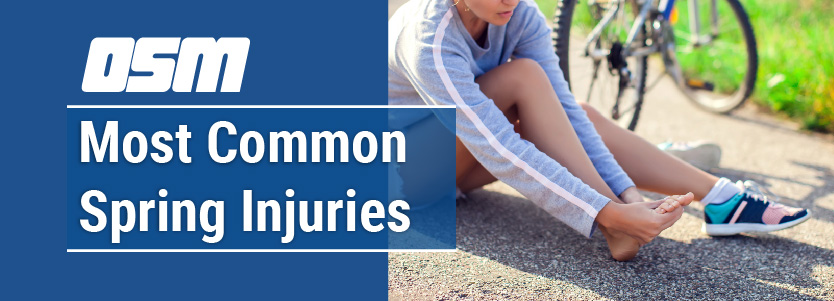Article featured on CareNow Urgent Care
As the weather warms up and the flowers begin to bloom, many people are eager to spend more time outdoors and engage in activities that they may have put on hold during the winter months.
While spring is a time to enjoy the outdoors and soak up some vitamin D, it also comes with its fair share of risks, including the potential for injuries. From gardening mishaps to sports-related accidents, there are a variety of injuries that tend to be more common during the spring season.
We’re exploring some of the most common spring injuries, along with tips for prevention and treatment. Whether you’re an avid outdoor enthusiast or simply looking to enjoy the spring weather, it’s important to be aware of these common injuries so that you can take steps to stay safe and healthy.
What are the most common spring injuries?
There are certain injuries that typically occur more this time of year than any other season. Educating yourself on these injuries is the first step in learning how to prevent them. Here’s a look at the injuries most common during springtime:
Sprains and strains
Sprains and strains are common injuries that affect the soft tissues in the body, such as muscles, ligaments, and tendons. A sprain occurs when a ligament, the tissue that connects bone to bone, is stretched or torn.
This can happen due to a sudden twist or turn of the joint, resulting in pain, swelling, and difficulty moving the affected area.
On the other hand, a strain occurs when a muscle or tendon is inflamed, usually as a result of overuse or repetitive motion. Symptoms of a strain include pain, swelling, muscle spasm, and weakness.
Both sprains and strains can be treated with rest, ice, compression, and elevation, along with physical therapy and pain management techniques. However, severe cases may require surgery to repair the damaged tissue.
Fractures
Fractures, or broken bones, can happen any time of year, but they are particularly common during the spring season. With the arrival of warmer weather, many people become more active, and this can increase the risk of falls, collisions, and other accidents that can result in fractures.
Common spring activities such as biking, skateboarding, and playing sports can also increase the risk of fractures. It’s important to take steps to prevent fractures, such as wearing proper protective gear and taking precautions to avoid falls.
Sunburn and heat-related illness
With warmer temperatures and longer days, many people spend more time outdoors during the spring season. However, spending too much time in the sun can increase the risk of sunburn and heat-related illnesses.
Sunburn can be painful and uncomfortable, and it also increases the risk of skin cancer. Heat-related illnesses such as heat exhaustion and heat stroke can be serious and even life-threatening.
It’s important to take steps to protect yourself from the sun and heat, such as wearing protective clothing, sunscreen, staying hydrated, and taking breaks in the shade or indoors. By being proactive, you can enjoy the outdoors safely during the spring season.
Bites and stings
Bites and stings from insects can be a common occurrence during the spring season, especially as people spend more time outdoors. While many insect bites and stings are harmless and cause only mild irritation, others can be more serious and lead to an allergic reaction or infection.
When possible, take steps to avoid insect bites and stings, such as wearing protective clothing and using insect repellent. If a bite or sting does occur, it’s important to monitor the area for signs of infection or allergic reaction and seek medical attention if necessary.
Overuse injuries
Spring is a popular time for people to ramp up their exercise routines after a long winter, but overdoing it can lead to overuse injuries like tendonitis, shin splints, and stress fractures. It’s important to gradually increase your activity level and listen to your body to avoid these types of injuries.
How to prevent common spring injuries
Preventing injuries is always better than treating them after the fact. When it comes to spring injuries, there are several things you can do to reduce the risk of getting hurt.
First, it’s important to stay active throughout the year, rather than suddenly jumping into strenuous activities once the weather warms up. This helps your body adjust to the increased activity level and reduces the risk of injury. Warming up before physical activity, wearing protective gear, and staying hydrated can all help prevent injuries.
Another way to prevent spring injuries is to be aware of potential hazards and take steps to avoid them. For example, wearing the right footwear and being aware when you walk on uneven surfaces can help prevent ankle sprains and other foot injuries.
Taking precautions to avoid insect bites, such as using bug spray and wearing long sleeves and pants in wooded areas, can also help reduce the risk of allergic reactions and other insect-related injuries.
Finally, you should always seek medical attention if you experience an injury rather than trying to tough it out or self-diagnose it. Delaying treatment can lead to more serious complications and a longer recovery time. By taking these preventative measures, you can reduce the risk of injury and enjoy the gorgeous spring weather.



